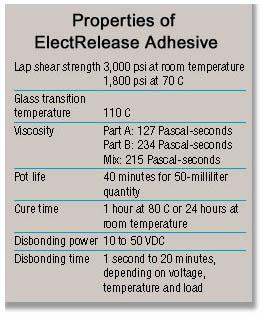
Working with a grant from the Air Force's Small Business Innovative Research program, EIC Laboratories Inc. (Norwood, MA) came up with a solution: a high-strength adhesive that disbonds from a metal surface when an electrical current passes across the epoxy-metal interface. Called ElectRelease, the new adhesive is a two-part, amine-cured epoxy.
The typical voltage required to break the bond is 10 to 50 VDC, resulting in a current flow of less than 1 milliampere per square inch of bond line. This low power does not produce heat during disbonding. The parts separate at the positive interface without mechanical, thermal or chemical damage.
The adhesive works with aluminum and its alloys, high alloy steel, carbon steel, stainless steel, copper and titanium.
Because electrical current, in the form of ions, flows through the epoxy during disbonding, electrochemical reactions occur at both the positive and negative interfaces between the adhesive and the metal substrates. How-ever, the electrochemical reactions at the negative interface do not cause disbonding.

To bond nonconductive materials or painted surfaces, EIC developed an ElectRelease foil patch. The patch consists of two sheets of metal foil, usually aluminum, laminated with a thin layer of precured ElectRelease. The patches are cut to shape, and any standard adhesive is applied to each surface. The nonmetallic parts are then bonded with the adhesive-coated patch. The parts are disbonded by applying a voltage between the two metal foils. The bond separates at the interface between the ElectRelease and the positive foil.
For more information, call EIC Laboratories at 781-769-9450, visit www.eiclabs.com.


